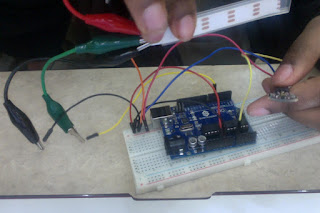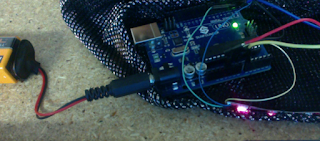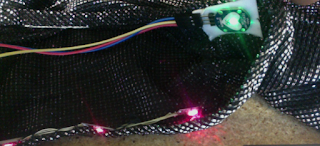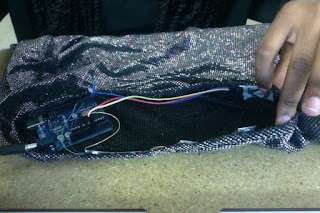My prototype for my final is a light up dress that lights up with your heartbeat.
The Materials used were:
5v battery
Arduino
Heart pulse sensor
Jumper wires
ultra thin wire
5 neopixel Strip
double sided tape
black thread
Scissors
Bread board circuit:
Wiring set up:
Here is the code used for this project:
#include <Adafruit_NeoPixel.h> // Library containing
// Behavior setting variables
int pulsePin = 0; // Pulse Sensor purple wire connected to analog pin 0
int blinkPin = 13; // Digital pin to blink led at each beat
int fadePin = 5; // pin to do fancy neopixel effects at each beat
int fadeRate = 0; // used to fade LED on with PWM on fadePin
// these variables are volatile because they are used during the interrupt service routine
volatile int BPM; // used to hold the pulse rate
volatile int Signal; // holds the incoming raw data
volatile int IBI = 600; // holds the time between beats, the Inter-Beat Interval
volatile boolean Pulse = false; // true when pulse wave is high, false when it’s low
volatile boolean QS = false; // becomes true when Arduoino finds a beat.
volatile int rate[10]; // used to hold last ten IBI values
volatile unsigned long sampleCounter = 0; // used to determine pulse timing
volatile unsigned long lastBeatTime = 0; // used to find the inter beat interval
volatile int P =512; // used to find peak in pulse wave
volatile int T = 512; // used to find trough in pulse wave
volatile int thresh = 512; // used to find instant moment of heart beat
volatile int amp = 100; // used to hold amplitude of pulse waveform
volatile boolean firstBeat = true; // used to seed rate array so we startup with reasonable BPM
volatile boolean secondBeat = true; // used to seed rate array so we startup with reasonable BPM
// Set up use of NeoPixels
const int NUMPIXELS = 5; // Put the number of NeoPixels you are using here
const int BRIGHTNESS = 60; // Set brightness of NeoPixels here
Adafruit_NeoPixel strip = Adafruit_NeoPixel(NUMPIXELS, fadePin, NEO_GRB + NEO_KHZ800);
// THIS IS THE TIMER 2 INTERRUPT SERVICE ROUTINE.
// Timer 2 makes sure that we take a reading every 2 miliseconds
ISR(TIMER2_COMPA_vect){ // triggered when Timer2 counts to 124
cli(); // disable interrupts while we do this
Signal = analogRead(pulsePin); // read the Pulse Sensor
sampleCounter += 2; // keep track of the time in mS with this variable
int N = sampleCounter – lastBeatTime; // monitor the time since the last beat to avoid noise
// find the peak and trough of the pulse wave
if(Signal < thresh && N > (IBI/5)*3){ // avoid dichrotic noise by waiting 3/5 of last IBI
if (Signal < T){ // T is the trough
T = Signal; // keep track of lowest point in pulse wave
}
}
if(Signal > thresh && Signal > P){ // thresh condition helps avoid noise
P = Signal; // P is the peak
} // keep track of highest point in pulse wave
// NOW IT’S TIME TO LOOK FOR THE HEART BEAT
// signal surges up in value every time there is a pulse
if (N > 250){ // avoid high frequency noise
if ( (Signal > thresh) && (Pulse == false) && (N > (IBI/5)*3) ){
Pulse = true; // set the Pulse flag when we think there is a pulse
digitalWrite(blinkPin,HIGH); // turn on pin 13 LED
IBI = sampleCounter – lastBeatTime; // measure time between beats in mS
lastBeatTime = sampleCounter; // keep track of time for next pulse
if(firstBeat){ // if it’s the first time we found a beat, if firstBeat == TRUE
firstBeat = false; // clear firstBeat flag
return; // IBI value is unreliable so discard it
}
if(secondBeat){ // if this is the second beat, if secondBeat == TRUE
secondBeat = false; // clear secondBeat flag
for(int i=0; i<=9; i++){ // seed the running total to get a realisitic BPM at startup
rate[i] = IBI;
}
}
// keep a running total of the last 10 IBI values
word runningTotal = 0; // clear the runningTotal variable
for(int i=0; i<=8; i++){ // shift data in the rate array
rate[i] = rate[i+1]; // and drop the oldest IBI value
runningTotal += rate[i]; // add up the 9 oldest IBI values
}
rate[9] = IBI; // add the latest IBI to the rate array
runningTotal += rate[9]; // add the latest IBI to runningTotal
runningTotal /= 10; // average the last 10 IBI values
BPM = 60000/runningTotal; // how many beats can fit into a minute? that’s BPM!
QS = true; // set Quantified Self flag
// QS FLAG IS NOT CLEARED INSIDE THIS ISR
}
}
if (Signal < thresh && Pulse == true){ // when the values are going down, the beat is over
digitalWrite(blinkPin,LOW); // turn off pin 13 LED
Pulse = false; // reset the Pulse flag so we can do it again
amp = P – T; // get amplitude of the pulse wave
thresh = amp/2 + T; // set thresh at 50% of the amplitude
P = thresh; // reset these for next time
T = thresh;
}
if (N > 2500){ // if 2.5 seconds go by without a beat
thresh = 512; // set thresh default
P = 512; // set P default
T = 512; // set T default
lastBeatTime = sampleCounter; // bring the lastBeatTime up to date
firstBeat = true; // set these to avoid noise
secondBeat = true; // when we get the heartbeat back
}
sei(); // enable interrupts when youre done!
}// end isr
void interruptSetup(){
// Initializes Timer2 to throw an interrupt every 2mS.
TCCR2A = 0x02; // DISABLE PWM ON DIGITAL PINS 3 AND 11, AND GO INTO CTC MODE
TCCR2B = 0x06; // DON’T FORCE COMPARE, 256 PRESCALER
OCR2A = 0X7C; // SET THE TOP OF THE COUNT TO 124 FOR 500Hz SAMPLE RATE
TIMSK2 = 0x02; // ENABLE INTERRUPT ON MATCH BETWEEN TIMER2 AND OCR2A
sei(); // MAKE SURE GLOBAL INTERRUPTS ARE ENABLED
}
void setup(){
pinMode(blinkPin,OUTPUT); // pin that will blink to your heartbeat!
Serial.begin(115200); // Serial output data for debugging or external use
strip.begin();
strip.setBrightness(BRIGHTNESS);
for (int x=0; x < NUMPIXELS; x++) { // Initialize all pixels to ‘off’
strip.setPixelColor(x, strip.Color(20, 20, 20));
}
strip.show(); // Ensure the pixels are off
delay(1000); // Wait a second
interruptSetup(); // sets up to read Pulse Sensor signal every 2mS
}
void loop(){
// sendDataSerial(‘S’, Signal); // send Processing the raw Pulse Sensor data
if (QS == true){ // Quantified Self flag is true when arduino finds a heartbeat
fadeRate = 255; // Set ‘fadeRate’ Variable to 255 to fade LED with pulse
// sendDataSerial(‘B’,BPM); // send heart rate with a ‘B’ prefix
// sendDataSerial(‘Q’,IBI); // send time between beats with a ‘Q’ prefix
QS = false; // reset the Quantified Self flag for next time
}
ledFadeToBeat(); // Routine that fades color intensity to the beat
delay(20); // take a break
}
void sendDataSerial(char symbol, int data ) {
Serial.print(symbol); // symbol prefix tells Processing what type of data is coming
Serial.println(data); // the data to send culminating in a carriage return
}
void ledFadeToBeat() {
fadeRate -= 15; // Set LED fade value
fadeRate = constrain(fadeRate,0,255); // Keep LED fade value from going into negative numbers
setStrip(fadeRate); // Write the value to the NeoPixels
// sendDataSerial(‘R’,fadeRate);
}
void setStrip(int r) { // Set the strip to one color intensity (red)
int g = 20; // Green is set to zero (for non-red colors, change this)
int b = 20; // Blue is set to zero (for non-red colors, change this)
for (int x=0; x < NUMPIXELS; x++) {
strip.setPixelColor(x, strip.Color(r, g, b));
}
strip.show();
}



